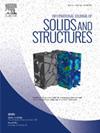基于最小手性减数分裂结构的负压缩性减数分裂超材料的统一平面泊松比设计方法(PPRDM
IF 3.4
3区 工程技术
Q1 MECHANICS
International Journal of Solids and Structures
Pub Date : 2025-06-23
DOI:10.1016/j.ijsolstr.2025.113494
引用次数: 0
摘要
减数分裂超材料是一种设计复杂的结构,其特征是正泊松比,超过了在天然材料中观察到的传统极限0.5。这个特殊属性允许它们分别垂直于应用的拉伸或压缩收缩或扩展。具有高正泊松比的结构表现出反直觉的负压缩性行为,在跨越各个领域的各种应用中具有重要的前景。尽管泊松比超材料的潜力巨大,包括减数分裂结构、渐缩结构和非渐缩结构,但由于缺乏有效的设计方法,它们的发展受到了阻碍。本文的目的是解决这一限制,集中在减数分裂变异的一个最小的二维辅助结构最近提出。我们采用了一种结合两种拓扑变换的设计方法,不仅可以创建已知的减数分裂结构,而且可以在了解手性影响的同时促进新结构的生成。此外,所提出的方法能够将这些结构分类为三个具有减数分裂行为和负线性压缩性的非手性家族和三个具有减数分裂行为的手性家族。只有碱基手性结构在具有手性的同时表现出减数分裂行为。为了加强理解和标准化,我们引入了一个命名协议,并为这些结构定义了相关的单元。我们还深入研究了在这个框架内镶嵌的潜力。最后,我们的研究从表面应变的角度考察了减数分裂结构,这是一种与可压缩性相关的更一般的指标,为其独特的机械性能提供了进一步的见解。本文章由计算机程序翻译,如有差异,请以英文原文为准。
A unified Planar Poisson’s Ratio Design Method (PPRDM) for meiotic metamaterials that exhibit negative compressibility based on a minimal chiral meiotic structure
Meiotic metamaterials are intricately designed structures characterized by a positive Poisson’s ratio, surpassing the conventional limit of 0.5 observed in natural materials. This exceptional attribute allows them to contract or expand perpendicularly to the applied stretch or compression, respectively.
Structures featuring a high positive Poisson’s ratio exhibit a counter-intuitive negative compressibility behavior, holding significant promise for diverse applications spanning various domains.
Despite the potential of Poisson’s ratio metamaterials, including auxetic, anepirretic, and meiotic structures, their recent development has been hindered by the lack of efficient design methods. This paper aims to address this limitation, concentrating on the meiotic variant of a minimal 2D auxetic structure recently proposed. We employ a design method incorporating two topological transformations, not only enabling the creation of known meiotic structures but also facilitating the generation of new ones while understanding the impact of chirality. Additionally, the proposed method enables the categorization of these structures into three achiral families that present meiotic behavior and can exhibit negative linear compressibility and three chiral families that possess an auxetic behavior. Only the base chiral structure was found to exhibit a meiotic behavior while being chiral.
In an effort to enhance comprehension and standardization, we introduce a naming protocol and define the associated unit cell for these structures. We also delve into the potential of tessellations within this framework. Finally, our study examines meiotic structures from the perspective of surface strain, a more general metrics, linked to the compressibility, providing further insights into their unique mechanical properties.
求助全文
通过发布文献求助,成功后即可免费获取论文全文。
去求助
来源期刊
CiteScore
6.70
自引率
8.30%
发文量
405
审稿时长
70 days
期刊介绍:
The International Journal of Solids and Structures has as its objective the publication and dissemination of original research in Mechanics of Solids and Structures as a field of Applied Science and Engineering. It fosters thus the exchange of ideas among workers in different parts of the world and also among workers who emphasize different aspects of the foundations and applications of the field.
Standing as it does at the cross-roads of Materials Science, Life Sciences, Mathematics, Physics and Engineering Design, the Mechanics of Solids and Structures is experiencing considerable growth as a result of recent technological advances. The Journal, by providing an international medium of communication, is encouraging this growth and is encompassing all aspects of the field from the more classical problems of structural analysis to mechanics of solids continually interacting with other media and including fracture, flow, wave propagation, heat transfer, thermal effects in solids, optimum design methods, model analysis, structural topology and numerical techniques. Interest extends to both inorganic and organic solids and structures.

 求助内容:
求助内容: 应助结果提醒方式:
应助结果提醒方式:


